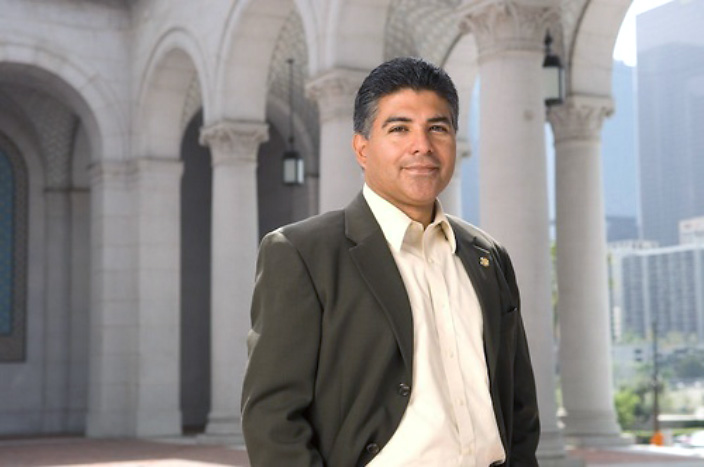
Tony Cárdenas / Twitter
“We need to focus on how we reduce crime in America rather than the solely punitive solution of locking people up,” said Rep. Tony Cárdenas, D-Calif.
WASHINGTON — Tear down more state youth prisons, and spend the money saved on community-based alternatives to incarceration.
Doing so, juvenile justice advocates say, would reduce overall youth crime and recidivism, keep nonviolent offenders from being incarcerated, save states millions of dollars and help the juvenile justice system live up to its mission to rehabilitate, not mostly warehouse, youths.
Against this backdrop, the Obama administration is seeking in its fiscal year 2016 juvenile justice budget a $30 million initiative known as “Smart on Juvenile Justice.”
The initiative is designed to help states decrease youth incarceration while increasing community-based alternatives to locking kids up and reducing racial and ethnic disparities.
“The Smart on Juvenile Justice Initiative will drive nationwide system reform, guiding states toward a developmentally informed approach that maximizes cost savings and strategically reinvests those savings into efforts that improve outcomes for youth,” said Robert Listenbee, administrator of the federal Office of Juvenile Justice and Delinquency Prevention, in an emailed statement.
Congress has yet to approve the requested funding, though the Obama administration has funded a pilot of the program, rolled out last year in Georgia, Hawaii and Kentucky, working with private foundations and the Washington-based nonprofit Pew Charitable Trust’s Public Safety Performance Project.

Incarceration is an option that is overused, wasting money and harming children, according to Liz Ryan, president and CEO of Youth First! Initiative.
The states, each of which received $200,000, worked to divert youths from the juvenile justice system, provide community-based alternatives, decrease correctional spending and improve public safety.
“It was clear the status quo was not working,” says a Pew video that points out the initiative has begun achieving many of its chief goals.
Juvenile justice advocates embraced the Obama administration’s request to take Smart on Juvenile Justice nationwide.
“If you look at the data for what kids are locked up for in the ‘deep end’ of the system, there’s a lot that shows that these kids don’t need to be incarcerated,” said Liz Ryan, president and CEO of the Washington-based nonprofit Youth First! Initiative, which seeks to dramatically reduce incarceration in state facilities while increasing community-based alternatives.
“You see the stats for kids with misdemeanors, you see kids in for probation violations, you see drug violations,” Ryan said. “We’re overusing the most expensive option for kids when we really don’t need to be doing that. It’s a waste. It’s a waste of money; it’s also harming children: The human cost is huge, and when we look at the fact that kids being sent through the juvenile justice system are far more likely to be incarcerated in the adult criminal justice system, we really have to ask why are we putting so many kids in locked facilities?”
The latest statistics on youths incarcerated in state facilities show about one in four had committed violent offenses. The remainder had been incarcerated for nonviolent offenses, according to the figures for 2011 from OJJDP.
Ryan said the $30 million initiative also reflects research on adolescents showing, among other things, that most kids engage in delinquent behavior at some point but almost all outgrow it.
“We really have to accelerate their success and help young people become successful adults,” Ryan said. “At times, the system is punitive and harsh and doesn’t in fact recognize that kids are capable of rehabilitation, kids are amenable to treatment and kids will age out of delinquency. We shouldn’t be doing anything that’s going to impede that progress.”
Like other juvenile justice advocates, Ryan pointed to the nonprofit Youth Advocate Programs Inc. as a model of community-based alternatives to incarceration.
YAP, based in Harrisburg, Pa., relies on “advocates” — paid, trained and supervised adults recruited from the same communities as the youth and families they serve.
The advocates work with many youths who have committed serious offenses and provide a broad array of 24/7 services, including intensive supervision, mentoring and working with judges, probation officers and case managers.

“Our biggest investment should be in building a neighborhood-based continuum of care to keep families together, not separate them,” said Shaena Fazal, national policy director at YAP.
Advocates work closely with families of the offenders, who live at home during treatment, and help the offenders find part-time employment and community service projects while helping them set and achieve goals.
“It is critical that we redirect dollars from cages to the community; the dollars should follow the kids home,” said Shaena Fazal, national policy director for YAP, which provides its intensive community-based services in 17 states.
“Our biggest investment should be in building a neighborhood-based continuum of care to keep families together, not separate them,” Fazal said.
“To be smart on juvenile justice, we must invest in supporting and empowering communities to build a robust continuum of care for young people with complex needs,” she said. “Right now, the dollars communities need to build this continuum are tied up in youth prison cells and residential centers.”
Rep. Tony Cárdenas, D-Calif., known for his work on juvenile justice, agreed.
“We need to focus on how we reduce crime in America rather than the solely punitive solution of locking people up,” Cardenas said in an email.
“Locking up nonviolent offenders creates a cycle of incarceration that causes more children to end up in single-parent homes and an increased likelihood of re-offending. There are effective alternatives to incarceration that reduce recidivism and save taxpayer dollars.”
Like Ryan, Cardenas also noted increasing bipartisan support for juvenile justice reform, which could improve the chances the national Smart on Juvenile Justice provision is enacted.
Fazal applauded that growing support: “We still need more leaders in Congress to step up, and supporting efforts to ‘decarcerate’ youth and redirect dollars to the community to help the young people who need it most is an ideal place to start.”
Ryan also cited a recent study, Closer to Home: An Analysis of the State and Local Impact of the Texas Juvenile Justice Reforms, that scrutinized results of sweeping juvenile justice reforms in the state.
The study found that Texas cut by 66 percent the average daily population of youths incarcerated in state facilities from 2007 to 2012. During the same period, the study found, juvenile arrests declined nearly 33 percent, and eight of 10 youths were not arrested after completing community-based programs.
On the flip side, the Texas study also found those who were incarcerated in state facilities were 21 percent more likely to be arrested again and three times more likely to commit a felony than a youth under community supervision.
Savings from a fundamental shift away from incarceration for nonviolent offenses could be substantial, considering it costs upwards of $100,000 a year in some states — and much more in others — to incarcerate a child.
In contrast, it costs only about a fourth of that amount for community-based alternatives, which produce better results for all but the most serious offenders. This is no small matter at a time of shrinking state budgets.
There has been progress: Youth incarceration has been reduced by almost half over the past decade. And states including New York, Ohio, Illinois and Texas as well as Washington, D.C., have limited offenses for which youth can be incarcerated and expanded alternatives.
Still, considerable obstacles to reforms remain:
- Opposition to closing facilities comes from powerful prison unions, leaders and staff at juvenile correctional agencies, law enforcement officers and prosecutors, private prison leaders, crime victims’ groups and towns where juvenile facilities are located because of the prospect of the loss of jobs, advocates say.
- Reforms have resulted in closures of some state facilities, but merely moved youth to incarceration at the local level — in California and Ohio, for example. This suggests the need for stronger requirements on use of incentive funding to states for closing facilities, lest state incarceration be replaced by local incarceration.
- Savings from reduced incarceration, especially youth prison closures, often have not gone toward community-based, nonresidential alternatives to incarceration. In some cases, the savings go to probation departments, for example, not alternatives to incarceration run by community-based organizations.
- Even with the huge drop in youth incarceration, only about 50 state juvenile prisons have closed in the past decade, while about 200 continue to operate, advocates say, prompting some to call for razing many of these facilities.
- Some advocates suggest that based on documents they have reviewed, states are likely spending roughly the same amount on juvenile justice as before the decline in youth incarceration, meaning the cost per incarcerating each child has climbed.
- At least another 50 percent reduction in youth incarceration could be made based on Justice Department data showing two-thirds of incarcerated youths pose no risk to public safety, juvenile justice advocates maintain.
- States have largely overlooked reducing length of offenders’ stay, assuming more time imprisoned would improve outcomes for youths. Research, however, shows few benefits after six months of incarceration. Some youths also remain locked up because of a lack of appropriate placement in the community.
Pingback: Provision Aims to Get ‘Smart on Juvenile Justice’ (Office of Juvenile Justice and Delinquency Prevention) | Revolving Door